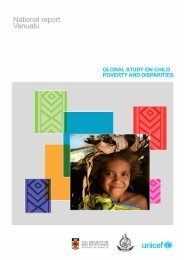STRATEGIC ASSESSMENT OF THE CHILDREN’S SERVICES INDUSTRYNEW SOUTH WALESPreschool Investment and Reform PlanThe NSW Government provides $140.5 million per annum to children’s services in NSW via<strong>the</strong> Department <strong>of</strong> Community <strong>Services</strong> (DoCS). It will invest an additional $29.8 million perannum from 2008/2009 under <strong>the</strong> Preschool Investment and Reform Plan (PIRP) to improveaccess to quality preschool programmes for all children in <strong>the</strong>ir year prior to school, withpriority to be given to <strong>the</strong> needs <strong>of</strong> disadvantaged children and communities.DoCS has undertaken a comprehensive mapping <strong>of</strong> all children’s services provided in NSW,at <strong>the</strong> Local Government Area level, as part <strong>of</strong> <strong>the</strong> service system analysis for (PIRP).This mapping includes all services available –- preschools, long day care, occasional care,family day and home based care – and all providers – commercial, community based,Department <strong>of</strong> Education and Training, and local government. Work is also underway to map<strong>the</strong> 0-5 years and preschool aged child populations at <strong>the</strong> LGA level, including mapping keydisadvantage indicators (e.g. socioeconomic, Aboriginal, Culturally and LinguisticallyDiverse (CALD), remote locations).This mapping has provided <strong>the</strong> information for detailed analysis <strong>of</strong> <strong>the</strong> current supply <strong>of</strong>children’s services relative to child population and will inform decisions regarding prioritylocations for new services and investment.This is significant as a planning approach as it has been developed to specifically recogniseboth child care service models and preschool service models and assess relative need foraccess against a combined measure <strong>of</strong> services. In <strong>the</strong> past such assessments have tended totreat <strong>the</strong> services as separate and distinct.This new planning approach is complemented by a significant programme <strong>of</strong> funding reformand increased expenditure.The basis <strong>of</strong> <strong>the</strong> new approach is to match preschool funding levels to <strong>the</strong> actualcharacteristics <strong>of</strong> <strong>the</strong> children and community in which <strong>the</strong> preschool operates, and <strong>the</strong> pattern<strong>of</strong> usage <strong>of</strong> services by <strong>the</strong> community.This means that <strong>the</strong> same funding rules will apply across all preschools ra<strong>the</strong>r than fundingbeing allocated on largely historical factors which are not responsive to changing child andfamily needs.The funding model is also designed to provide higher rates <strong>of</strong> funding to Indigenous children,children from low income families, and children from CALD backgrounds.Mobile preschools and preschools located in remote communities will also receive higherrates <strong>of</strong> funding to reflect <strong>the</strong> extra costs associated with <strong>the</strong>se services, and to assist familiesin isolated communities access early childhood education.55
STRATEGIC ASSESSMENT OF THE CHILDREN’S SERVICES INDUSTRYNORTHERN TERRITORYChild care in <strong>the</strong> Galiwin’ku community on Elcho Island 8In 1999, a purpose-built child care centre was built at Galiwin’ku on Elcho Island for children0 to 3 years old. In April, 2003 <strong>the</strong>re were 29 children attending, <strong>of</strong> whom most were children<strong>of</strong> parents who worked. The child care centre charges parents $5 per day, which isautomatically deducted from <strong>the</strong>ir pay. The centre has five community members on <strong>the</strong> childcare committee. All <strong>of</strong> <strong>the</strong> staff are Indigenous and have ei<strong>the</strong>r completed a Certificate III inCommunity <strong>Services</strong> (Children’s <strong>Services</strong>), or are currently studying for this and are involvedin <strong>the</strong> Community Development Education Programme (CDEP). Activities with <strong>the</strong> childreninclude finger-painting, reading stories and singing in both <strong>the</strong>ir own language and in English,doing puzzles, and sponge-painting. They are involved in <strong>the</strong> BBC (“Breathing, Blowing,Coughing”) health programme. The centre <strong>of</strong>fers a breakfast programme for all children.The children are all in toge<strong>the</strong>r, but in three areas – one for 1 year olds, one for 2 year oldsand one for 3 year olds. All <strong>the</strong> children stay all day (from 8 am to 4 pm), except for thosewho attend preschool in <strong>the</strong> mornings until 11.45am (currently four children). A bus brings<strong>the</strong>m back from <strong>the</strong> preschool, which is part <strong>of</strong> <strong>the</strong> school system. The preschool children lovesinging, and <strong>the</strong>y do activities such as counting, naming shapes, recognising <strong>the</strong>ir names andsome o<strong>the</strong>r words. They also learn manners and <strong>the</strong> importance <strong>of</strong> washing hands beforeeating. The children go from <strong>the</strong>re to <strong>the</strong> local primary school which has about 400 children.The teachers at <strong>the</strong> school have commented that <strong>the</strong> children who have entered school afterattending <strong>the</strong> child care centre are ahead <strong>of</strong> those who did not attend <strong>the</strong> centre.Because <strong>the</strong> centre is right in <strong>the</strong> middle <strong>of</strong> <strong>the</strong> community, it is convenient for staff to phone<strong>the</strong> mo<strong>the</strong>rs who are breast-feeding to come to <strong>the</strong> centre when <strong>the</strong>ir baby needs to be fed.There is a monthly clinic run by medical staff, but <strong>the</strong> children and <strong>the</strong>ir parents currently feelmore comfortable with <strong>the</strong> child care staff who can worm <strong>the</strong> children, and monitor <strong>the</strong>irweight and height. Policies have been introduced such as staff have to smoke outside, andparents have to register <strong>the</strong>ir child for child care each day and sign <strong>the</strong>m <strong>of</strong>f. If a child isunwell, staff will ring a parent (or relative) to take <strong>the</strong>ir child to <strong>the</strong> clinic. Parents also take<strong>the</strong>ir children to <strong>the</strong> clinic for immunisation.Parents <strong>of</strong> <strong>the</strong> children are involved with <strong>the</strong> child care centre in several ways, such as raisingmoney for <strong>the</strong> child care centre by running a market every fortnight, and selling clo<strong>the</strong>s, food,fish and crabs. O<strong>the</strong>r people involved in CDEP help catch <strong>the</strong> fish. People on CDEP help ino<strong>the</strong>r ways too, such as building cupboards and making sandpits, and <strong>the</strong> Aboriginal Councilhelps <strong>the</strong>m. Parents and extended family take <strong>the</strong> children on excursions eg to <strong>the</strong> beach or to<strong>the</strong> bush to collect wild honey and o<strong>the</strong>r traditional foods.The staff have a close relationship with <strong>the</strong> child care service at Yirrkala by talking andsharing ideas over <strong>the</strong> telephone. The Commonwealth Department <strong>of</strong> Family and Community<strong>Services</strong> has made some funds available for staff to travel to see o<strong>the</strong>r child care centres toexchange ideas.8 Source: Secretariat for National Aboriginal and Islander Child care and Centre for Community Child Health,2004.56
















